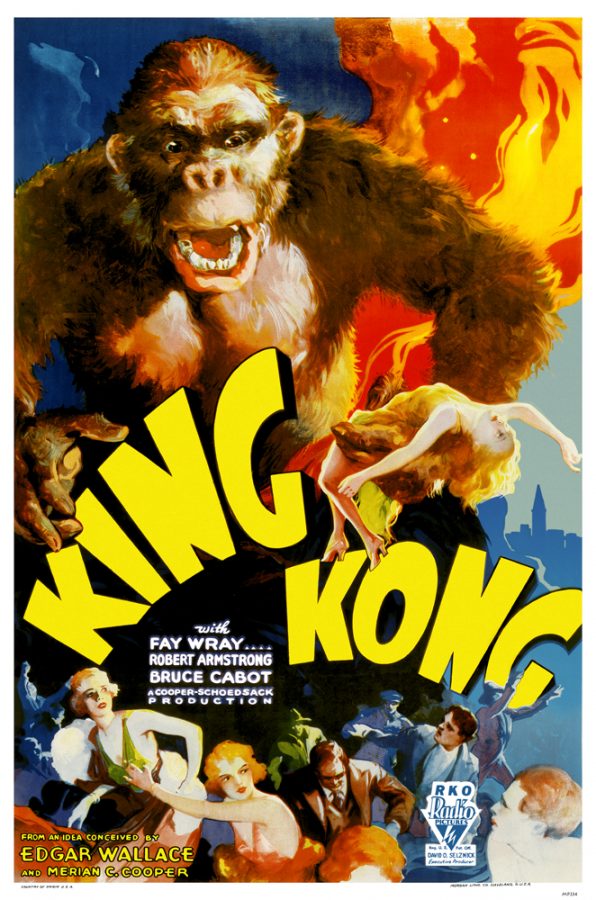REVIEW: “King Kong” still reigns as king of cinematic horror 88 years later
“Beauty and the Beast” takes on a bigger meaning in this riveting tale of two lovers who must survive a hostile island and its primal king.
March 15, 2021
When a film crew goes on a voyage to produce the greatest film ever made, they discover a mysterious island full of wonders and horrors. In their greed, they decide to bring something back with them. Something that never should have left the island.
“King Kong” (1933) is an adventure and fantasy film directed by Merian C. Cooper and Ernest B. Schoedsack.
Carl Denham (Robert Armstrong) sets out to find a leading lady for his new adventure film set on an island shrouded by mystery. By mere chance, he discovers Ann Darrow (Fay Wray), a young woman struggling to survive. The two of them board the Venture in search of fame alongside first-mate Jack Driscoll (Bruce Cabot) and the rest of the ship’s crew.
Together they set sail to an island rumored to have an enormous wall that protects them from a creature so gigantic that it acts as king of the island. Whilst on the island, they encounter island natives holding a sacrificial ceremony to their deity dubbed “Kong” a gorilla-like creature of enormous height and power. Later that night, Ann is kidnapped by the natives and offered as a sacrifice to Kong who takes her and goes further inside the prehistoric island.
Driscoll and the rest of the crew set out to rescue Ann from Kong’s clutches as they struggle to survive many of the island’s horrors that lie in store for them.
Filmed during an era in which the Great Depression was at its peak, “King Kong” serves as an achievement of cinematic history with revolutionary special effects that broke new ground in filmmaking.
With special effects that, while dated by today’s standards, were groundbreaking at the time. Artist Willis O’ Brien, a pioneer of the stop-motion technique, a method that uses models to convey movement frame by frame, helped in creating a wide array of prehistoric creatures that were brilliantly hidden in the foreground while a real cast interacted with them.
While these effects may appear goofy at first, viewers will be immersed in the cinematic magic of it all.
These effects also help to create an unsettling feeling in watching the creatures of the island interact with one another on-screen. Their staggered movement to uncanny realism only helps in adding more to the horror that ensues.
The beginning, while brief, shows a New York setting depicting poverty, which was something that was often glossed over in other films of the era. It quickly sets the tone of what’s to come in the film and why the cast is so desperate for fame and fortune after encountering Kong for its exploitation.
The film also does an excellent job at making the mysterious island feel like a grandiose adventure that’s waiting to be explored. Through an exposition of Armstrong’s character, we’re briefly told of what the island is and that there lies a creature of frightening strength on the other side of the island’s vast wall. This creates suspense for first-time viewers as they try to imagine what lies beyond the wall of “Skull Island.”
Wray’s performance perfectly encompasses that of a child who can’t help but peek behind the curtain. She brings a certain level of joy and romanticization to her character. Her character also acts as an audience’s reflection of the film. She becomes enamored by the mystery and thrill of it all that in turn, so does the audience’s curiosity.
What makes it more tragic as near the end of the film, is that most of Wray’s lines are of her explaining her memories of the horrors she’s endured on Skull Island. Wray is no longer the same person who blindly leaped into the opportunity of a lifetime. She’s transformed by the island’s unforgiving nature and thus forever traumatized by it all.
Another theme of the film is “beauty and the beast.” A line that characters like Carl Denham and Jack Driscoll seem to bring up religiously. Cabot’s character when we first meet him is this hardened chauvinist male who hates women. We come to realize that the reason Cabot’s character is so afraid of his inevitable love interest is that he’s afraid of becoming soft-natured.
This perfectly parallels Kong’s antagonistic nature as we see him brutalize and mutilate various prehistoric monsters of the island. To survive on this cruel island, Kong must rage relentlessly against both man and monster to prove why he’s king. Ultimately he too becomes victim to man’s harsh cruelty after falling for Ann Darrow.
Kong’s first arrival in the film will come as a complete shock as modern audiences will be more accustomed to a romanticized/pacifist nature version of him in later films.
In this original depiction, Kong is a malevolent creature whose childlike curiosity proves fatal for others. Each character’s death helps in selling Kong’s ferocity and brings a new level of gore that will prove unexpectedly horrifying upon first viewing.
To man, Kong is nothing but a creature of rage incarnate. To Kong, mankind is nothing but mere insects under his rule.
“King Kong” as a film stands as one of cinema’s greatest achievements in making audiences immerse themselves in this fantastical illusion of adventure that’s quickly shattered by the film’s harrowing truth. That man was never king.
Daniel Pineiro is a staff writer for the University Press. For more information regarding this or other stories, email [email protected] or @Danny_x101 on Instagram.






